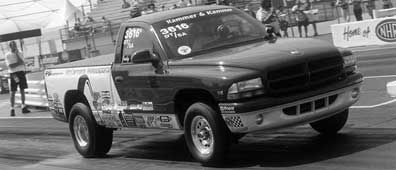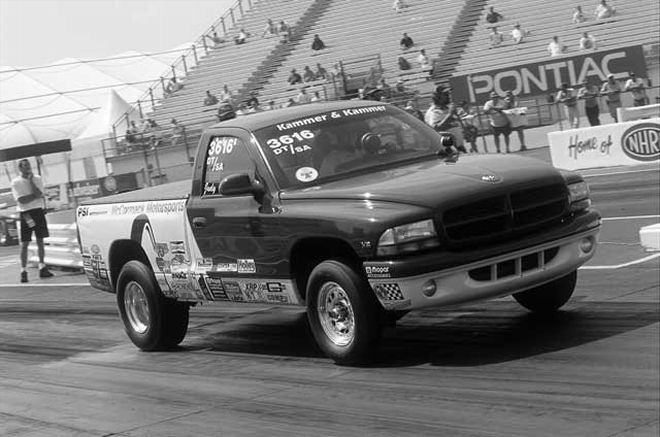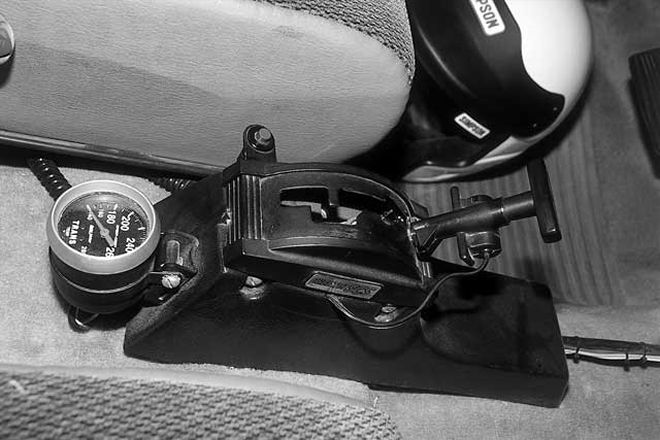

While many may lament the fact that most of the passenger cars in the present DaimlerChrysler lineup are front-wheel drive machines with less than eight cylinders, the current truck line from Dodge fills that need for speed quite well, thank you. Dakota trucks offer a great deal of opportunity for people who want traditional V8 performance, not to mention a nice comfort level and a mean look even when standing still. For those of us of the rear-wheel drive persuasion, one sure way to prove the prowess of our machines has always been in straight-line acceleration--drag racing.
In decades past, trucks would have been considered an unlikely candidate for such activities. Today, that's no longer the case. For instance, at the largest drag race of the year, NHRA's U.S. Nationals in Indianapolis, Dodge Dakotas scored top qualifying spots in both Stock and Super Stock--quite a feat considering that there were almost 400 other vehicles in the two categories--plus, the Dodges posted several class victories. Today's Magnum engines are far more advanced in their as-built modes when compared to the 340/360 mills of yesterday, and, as a result, will respond very well to changes for better racing and street performance.
Of the racing-oriented "truckers," few are more knowledgeable than Mopar Performance Tech Line's Jack McCormack. Jack has raced for years, fielding a wide variety of both new and old Mopar iron. His wife, Judy, driving a 2000 model Dakota, was the #1 Stock qualifier at Indy this year. Recently, we asked Jack to give us a rundown on what would be needed to get a truck ready for racing action.
While Jack runs most of his entries in Stock Eliminator competition, these tips give anybody who wants to go bracket racing some great baseline changes. Indeed, some of the changes listed here would not be legal in Stock racing. While some of the Mopar Performance parts are listed in the catalog as warranty items, that program has been discontinued (so these are not considered authorized service replacements). You might want to check with the dealer on what the changes below will do to your warranty. That said, here's what it takes to traverse the quarter-mile in your Dakota quicker than a speeding bullet...er, ticket.
Tip #1
Baseline--To establish what sort of performance you'd like to achieve with your Dakota, the best thing to do is find out where the vehicle is now. So the first time you go to the track, it's important to make as many runs as possible to find out what sort of elapsed times your truck is capable of. The benefit is that you can see what sort of additional performance gains you get from future changes. In addition to getting a baseline, buying the latest Mopar Performance catalog is a good idea at this point as well, so you can see what's available from the factory for your truck's engine package.
Tips #17, #18
Ignition system--The old standby of moving the battery toward the rear is good; even in NHRA Stock, where the battery needs to remain in the engine bay, a second battery in the bed is a good idea. Jack states that it's important to check the cable going to the front of the truck with a voltmeter at least a couple of times a year to ensure its integrity isn't compromised; the cable is subject to greater stresses than one might assume, and poor electric transfer will wreak havoc on the computer.
A better set of ignition wires helps ensure the engine's receiving the full benefit of the ignition system.

Tips #19, #20, #21
Trans upgrades--A reworked 904-type Torqueflite shows major gains. A professionally-built unit is expensive (probably $3000 or more for a full-race unit), but has the advantage of using aluminum and titanium internals for reduced drag and quicker rpm gains; it will increase performance by tenths, not hundredths. Plus, that overdrive unit in the OEM transmission eats up a ton of power. The replacement 904 requires a new driveshaft.
For street applications where the idea is to keep a little fuel economy, a standard aftermarket shift kit can be installed in the stock transmission to provide swifter, harder shifts (again, check on your warranty agreement).
Judy also uses a gated Turbo Action shifter on the trans to make sure there are no missed shifts, as well as a trans fluid temp gauge.
Tip #25
Get the book--This story is a basic overview of the potential changes to the Magnum 5.2/5.9 engine series in the Dakotas. At present, Larry Shepard at Mopar Performance is putting the finishing touches on the latest MP Speed Secrets manual, which will focus on the Magnum engine line. This 400-page volume will include the truck and crate motors, ranging from the 2.5L four-cylinder to the V10 truck Magnum crate package. If you plan to modify your truck for enhanced performance, it will be "must reading" once it is released.